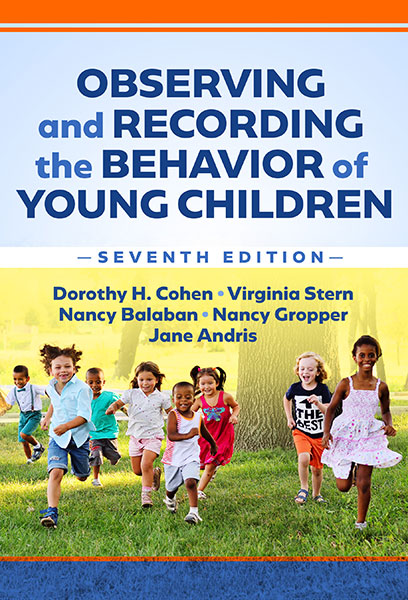Professors: Request an Exam Copy
Print copies available for US orders only. For orders outside the US, see our international distributors.
Seventh Edition
Dorothy H. Cohen, Virginia Stern, Nancy Balaban, Nancy Gropper, Jane Andris
Publication Date: May 24, 2024
Pages: 240

This classic text has been helping teachers better understand young children’s behavior for over 6 decades.
Now available in an updated seventh edition, this popular resource is designed to deepen pre- and inservice teachers’ understanding of children (birth–age 8) as unique individuals within a developmental context. Observation notes recorded over time reveal patterns in children’s behavior, as well as ways in which behaviors may change. To strengthen teachers’ efforts to better understand children as individuals, the authors provide a timeless methodology for documenting young children’s behavior as they actively engage in classroom life. They outline methods for record keeping that capture children’s interactions and experiences in the classroom. Numerous examples of teachers’ observations of children enrich this work and make it accessible, practical, and enjoyable to read.
Book Features:
Dorothy H. Cohen and Virginia Stern, both of whom passed away before the fourth edition, held faculty positions at Bank Street Graduate School of Education. Nancy Balaban is retired from Bank Street, where she was the director of the Infant and Family Development and Early Intervention Program. Nancy Gropper is retired from Bank Street, where she held positions as associate dean for academic affairs, department chair, and director of student teaching programs. Jane Andris, a Bank Street alumna, is a clinical assistant professor in the Early Childhood Research Center at the University of Louisville.
PRAISE FOR PREVIOUS EDITIONS—
"The sixth edition adds to the remarkable history of this volume with nuggets of updated insights reflecting the changing environments in which our children develop and grow."
—Jon Snyder, Stanford Center for Opportunity Policy in Education (for sixth edition)
"Responds to new knowledge about how children think, learn, and develop language, and about the influences of families, culture, and other environmental influences."
—Zero to Three (for fifth edition)
Contents
Preface to the Seventh Edition ix
1. Getting Started 1
Why Records? 1
Keeping Records 6
Language as a Tool in Recording 9
Importance of the Environment 12
2. Recording a Child’s Behavior During Routines 14
Organizing the Information 14
The Meaning of Routines to Young Children 18
Recording Eating Behavior 19
Recording Toileting Behavior 23
Recording Behavior at Rest Time 25
Recording Behavior During Transitions 27
Patterns of Behavior During Routines 28
3. Recording a Child’s Use of Materials 32
A Note on Technology 32
The Meaning of Materials to Young Children 33
What to Observe 38
Records of Use of Materials 40
How the Child Does What 41
Records Illustrating Detail 44
Interpretation: The Last Dimension 46
Patterns of Behavior in Use of Materials 47
4. Recording Children’s Behavior With One Another 51
How Children Learn to Socialize 51
Do We Really See What Is Going On? 55
What to Observe 57
Patterns of Behavior in Children’s Responses to Other Children 63
Group Membership 65
5. Recording Children’s Behavior in Dramatic Play 68
Capacity for Symbolic Representation 70
A Framework for Recording Dramatic Play 75
Focusing on Dramatic Roles 78
Social Aspects of Dramatic Play 84
Patterns of Behavior During Dramatic Play 91
6. Recording the Child’s Relationships With Adults and in Adult-Directed Activities 93
Teachers Observe Themselves 93
Recording a Child’s Interaction With an Adult 94
Gaining Information About a Child’s Larger Social World 99
Recording a Child in Teacher-Directed Group Activities 100
Patterns of Behavior in Children’s Relationships With Adults 102
7. Clues to Cognitive Functioning: Developmental Approach 106
How Do Children Learn? 106
Developmental Approach to Thinking in Early Childhood 108
How Can We Know a Child’s Approach to Thinking? 112
8. Clues to Cognitive Functioning: Individual Approach 122
Temperament of a Child 122
The Influence of Culture and Social Experience 123
How Do We Know What Children Are Thinking About and Learning? 124
How Can Teachers Discover What Children Know? 129
9. Observing Children Develop the Power to Think 134
Forming Generalizations 134
Ability to Differentiate 135
Ability to Perceive Similarities and Differences 136
Ability to Draw Analogies 136
Ability to Perceive Cause and Effect 137
Time Orientation 137
Ability to Seriate and Classify 139
Perceiving Patterns 140
Understanding Spatial Relationships 141
10. Recording Children’s Developing Language and Emerging Literacy 144
Language and Culture 144
Recording Children’s Use of Language 146
Observing Speech 155
Observing Emergent Literacy 160
11. Recording Behaviors That Are Disquieting 163
Value of Gathering Information 163
Examples of Unusual Behavior 164
12. Observing and Recording the Behavior of Infants and Toddlers 169
Making Sense of What You See 169
The Value of Recording 170
The Influence of Time of Day 171
What to Observe 172
13. Patterns—Summary—Interpretation 200
Patterns 200
Features of the Final Summary 203
Interpretation 208
Final Summary 209
References 213
Index 217
About the Authors 225
Professors: Request an Exam Copy
Print copies available for US orders only. For orders outside the US, see our international distributors.